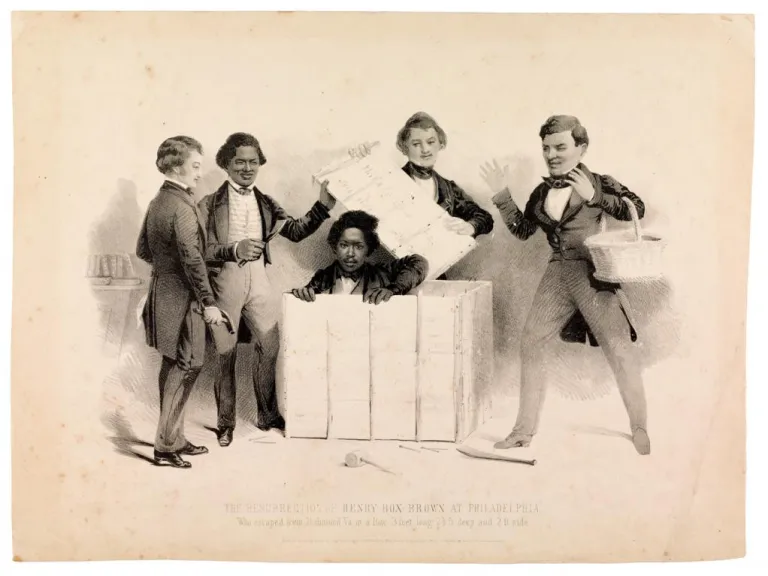One of the memorable escapes from slavery was that of Henry Brown of Richmond when, on March 29-30, he had himself shipped in a crate as railroad freight from Richmond to Philadelphia. He made the twenty-seven-hour journey to freedom crammed into a box measuring 3 x 2 ½ x 2 feet.
To celebrate his safe arrival, he adopted the name Henry “Box” Brown. This rare lithograph, titled The Resurrection of Henry “Box” Brown at Philadelphia, shows the moment that the box was opened in the office of the Pennsylvania Anti-Slavery Society and Brown emerged. The print is probably the only portrait of Henry Box Brown from life, and the artist likely also drew the box from life. None of the other figures accurately represent people who were at Brown's arrival; standing figures shown include (at right) James Miller McKim, who ran the Philadelphia Anti-Slavery office and a well-known abolitionist, and (second from left) Frederick Douglass, a stand-in for William Still of Philadelphia. A description of the production of this lithograph appears in The Unboxing of Henry Brown (2003) by Jeffrey Ruggles.
Once free, Brown appeared at abolitionist events and collaborated on a slave narrative. Using profits from the book, Brown produced a moving panorama depicting enslavement. Exhibiting the panorama helped lead Brown into a career of public performance.
This print by Samuel Worcester Rowse—who is remembered for his portraits of such figures as Henry David Thoreau, Nathaniel Hawthorne, and Ralph Waldo Emerson—was issued in 1850 in Boston to help raise funds for the panorama. The print in the VMHC collections is one of only a few known originals. Brown’s portrait is from life, and many other likenesses of him were based directly or indirectly on it. An inscription on the back of the print, "From Samuel May, 1889," probably refers to one of the two Samuel Mays who knew Brown. The Rev. Samuel J. May was a Unitarian minister who met Brown soon after his arrival in Philadelphia. His nephew, Samuel May, Jr., was an agent for the Massachusetts Anti-Slavery Society and spoke at the 1849 Convention about Brown, apparently becoming the first to confirm in public a story that was widely rumored: that Brown had indeed escaped in a box from Richmond.

